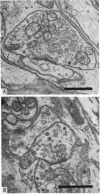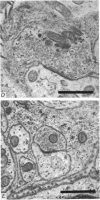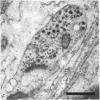Abstract
The ability of native (sympathetic preganglionic) and foreign (vagal) nerve fibres to re-innervate neurones of the guinea-pig superior cervical ganglion, either alone or in competition with each other, has been studied by means of intracellular recording and electron microscopy. 1. Native fibres make synaptic contacts with nearly all ganglion cells within one month of cervical trunk section; within 6 months the degree of innervation, judged by measurement of excitatory post-synaptic potential (e.p.s.p.) amplitude and electron microscopical synapse counts, approaches normal. However, even after 15 months innervation was weaker than in normal control ganglia. 2. Vagal fibres are less successful during re-innervation. Although a similar number of foreign fibres grown into denervated ganglia and make contact with nearly all ganglion cells within a month, after 6-12 months e.p.s.p. amplitudes in response to foreign nerve stimulation remain relatively small, and counts of synapses are only about 60% as great as in ganglia re-innervated with the native nerve. 3. When both native and foreign fibres are allowed to re-innervate ganglion cells simultaneously, about half the neurones in the ganglion receive synapses from both sources after 1 month. The proportion of dually invervated cells remains roughly constant for at least 14 months. Neither set of preganglionic fibres dominates or displaces the other, although neurones generally are re-innervated more effectively by native than foreign fibres, as is true during non-competitive re-innervation. 4. Thus during re-innervation of mammalian sympathetic neurones native fibres are preferred to foreign ones only in the sense that roughly the same number of native fibres form many more synapses on ganglion cells than do vagal axons. A foreign synapse, once formed, is as stable as a native one, and shows no tendency to be replaced by native terminals. These findings are discussed in relation to other evidence which has suggested specificity and selectivity during re-innervation of mammalian autonomic neurones.
Full text
PDF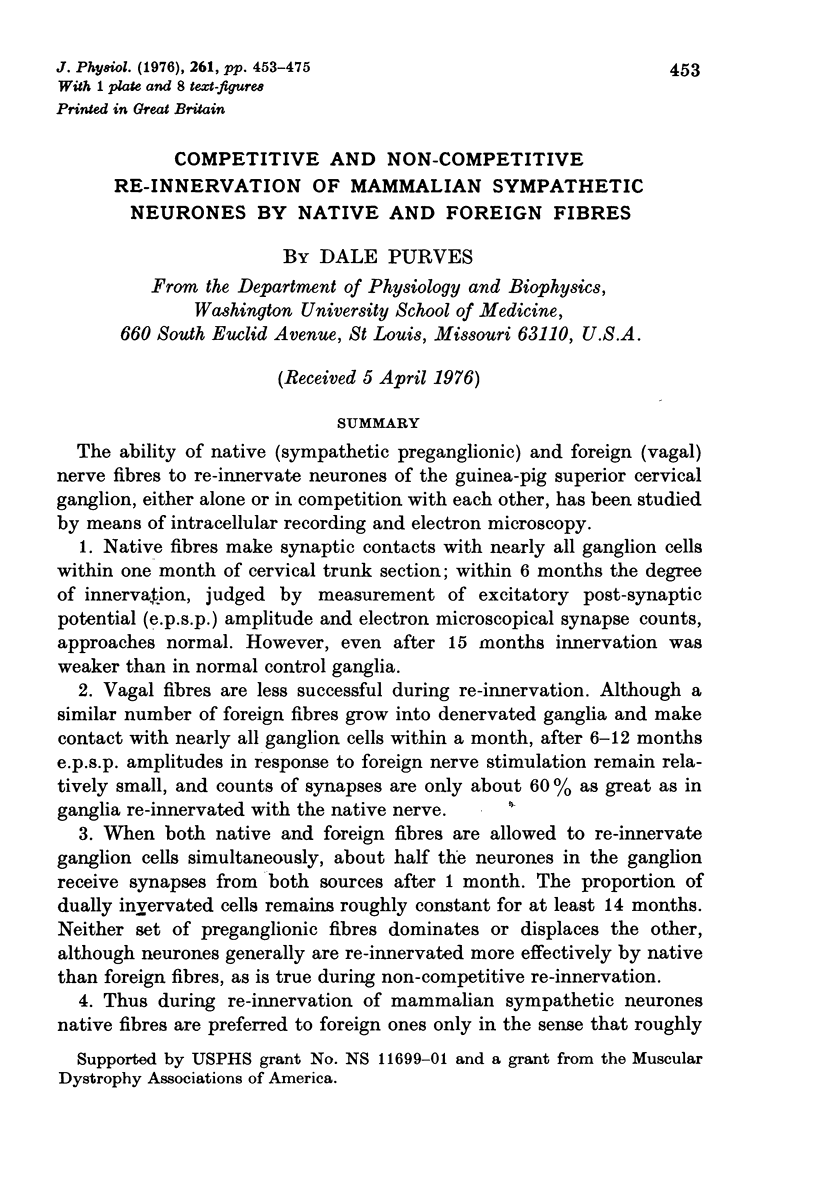
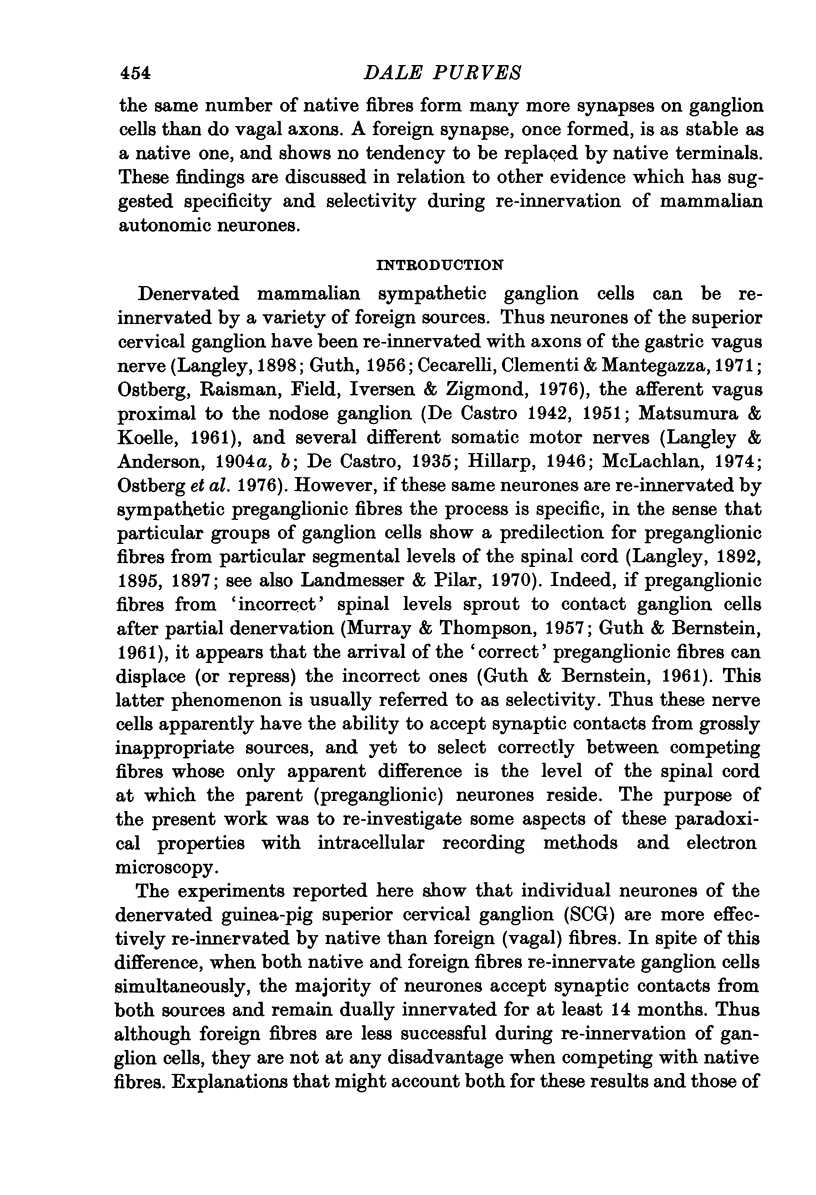
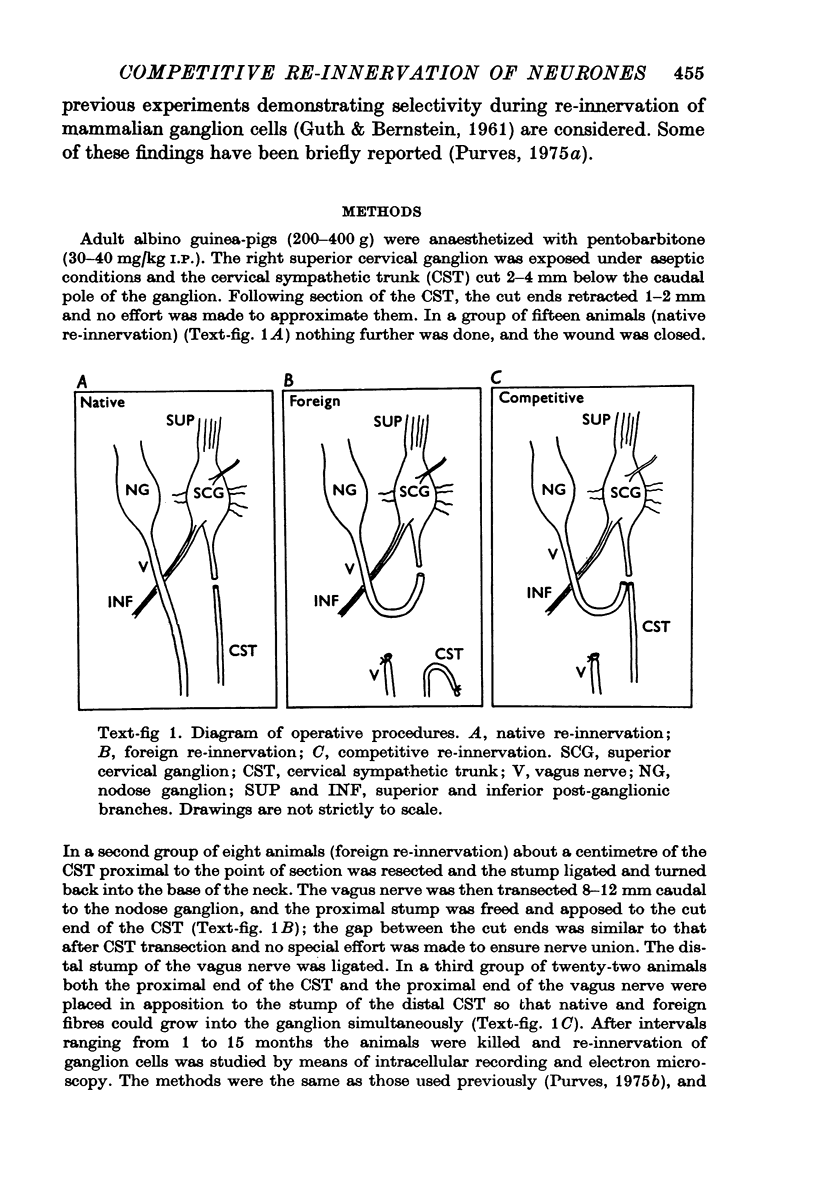
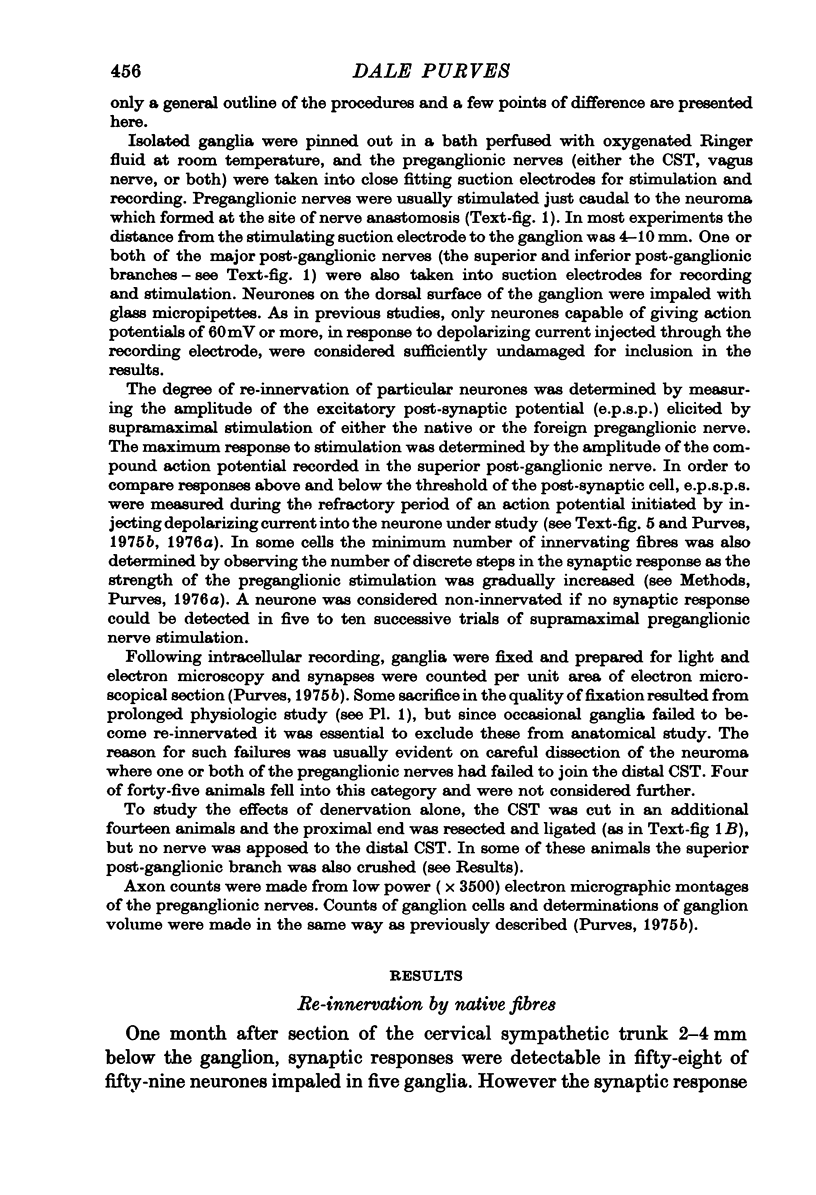
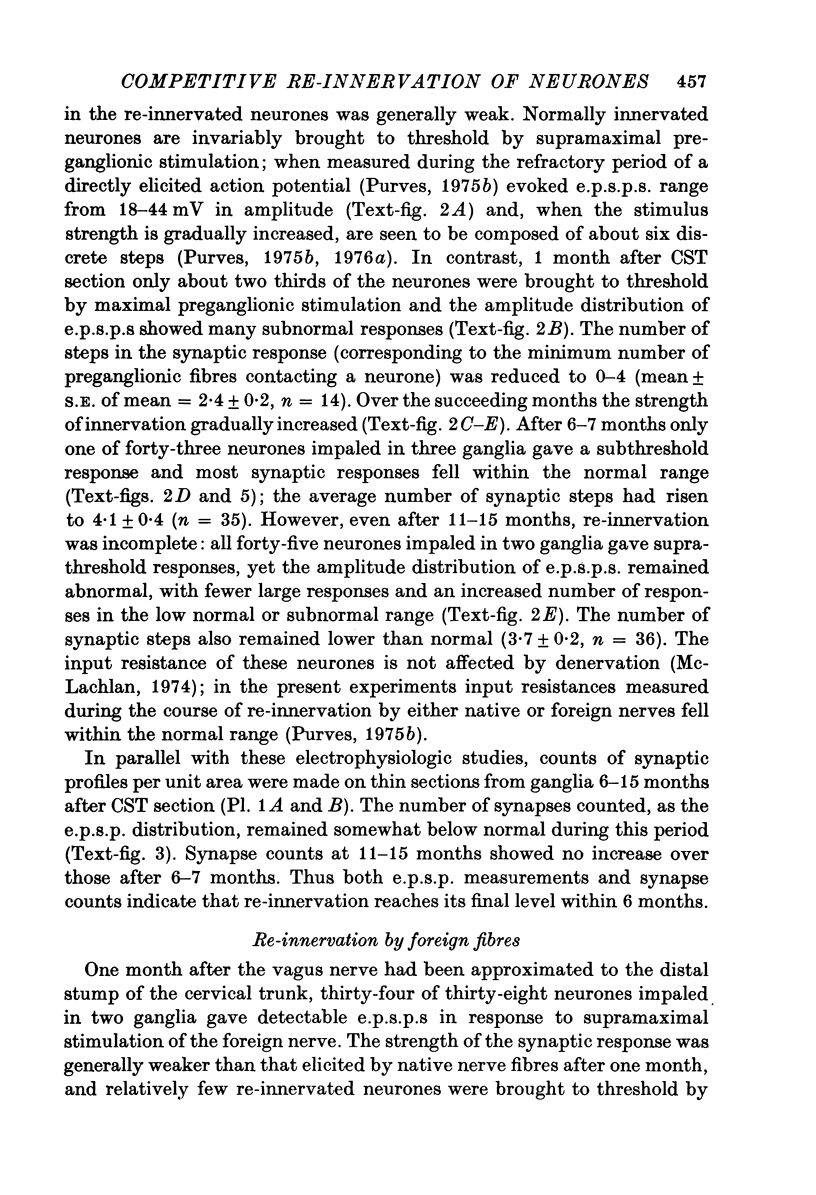
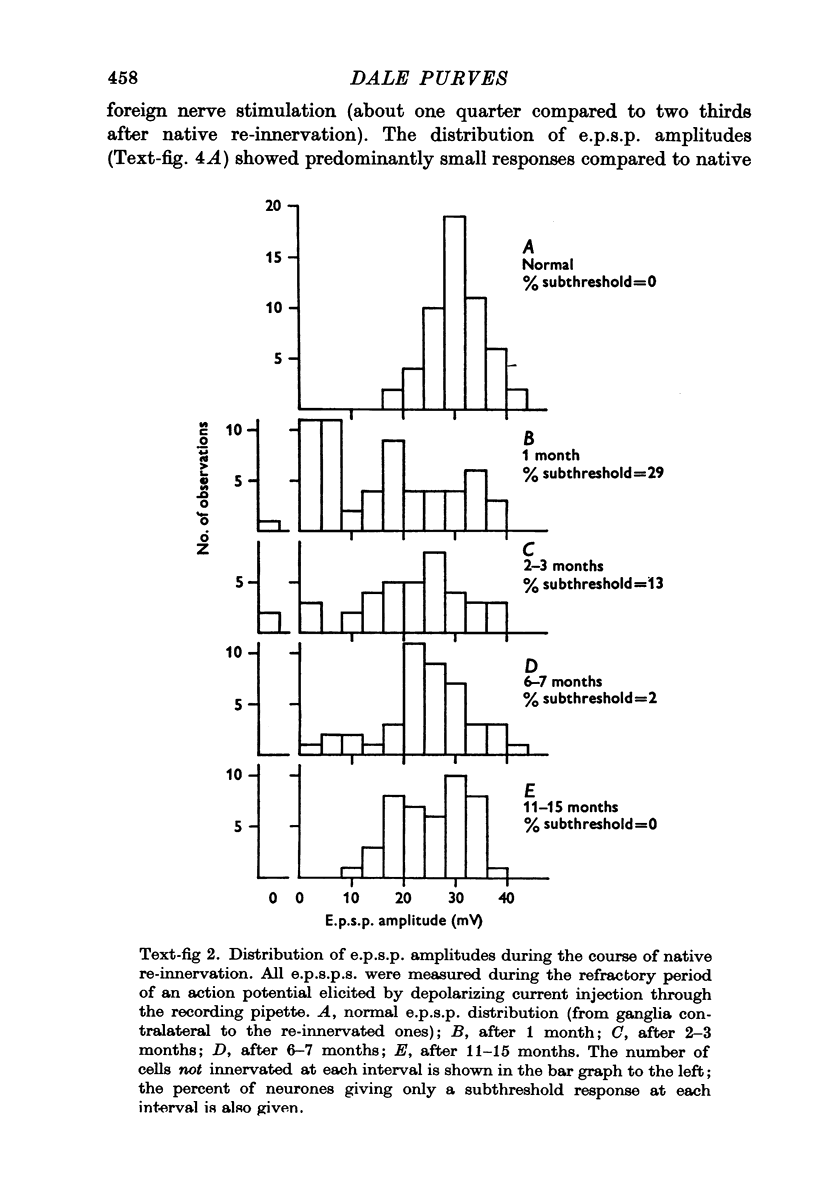
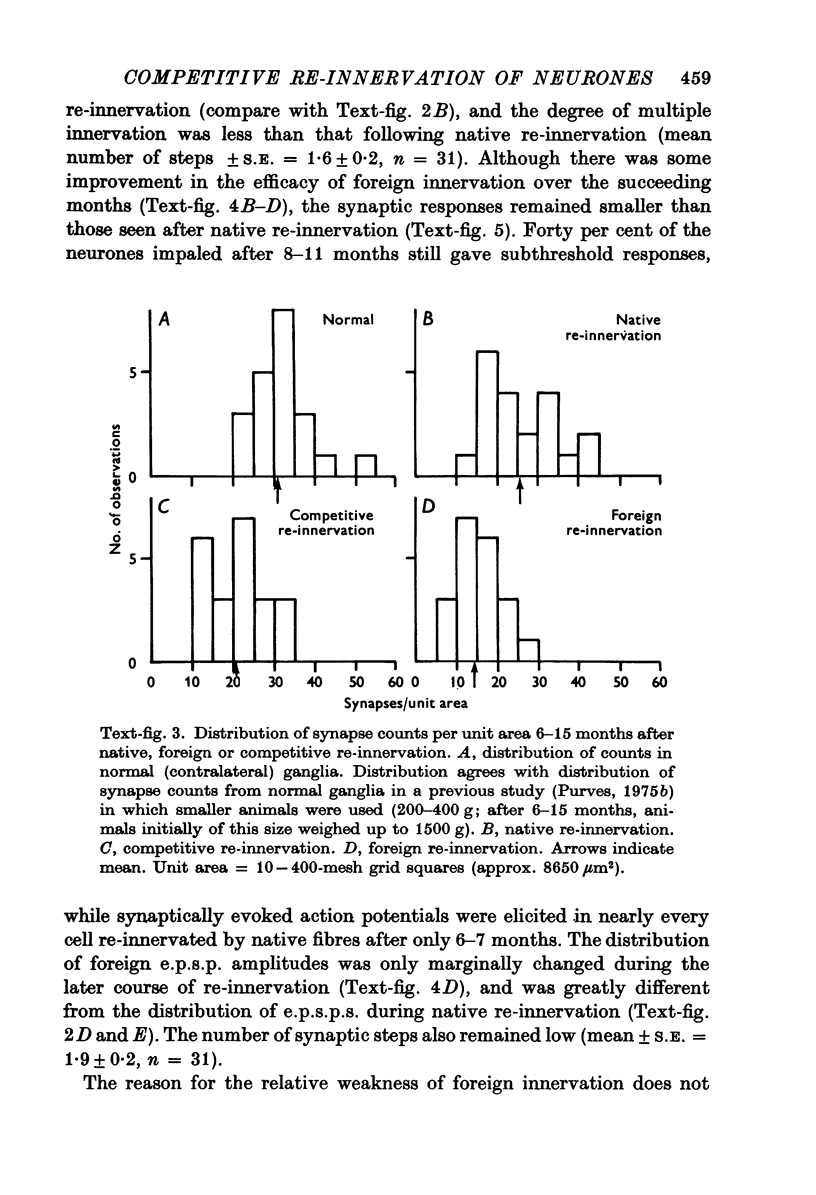
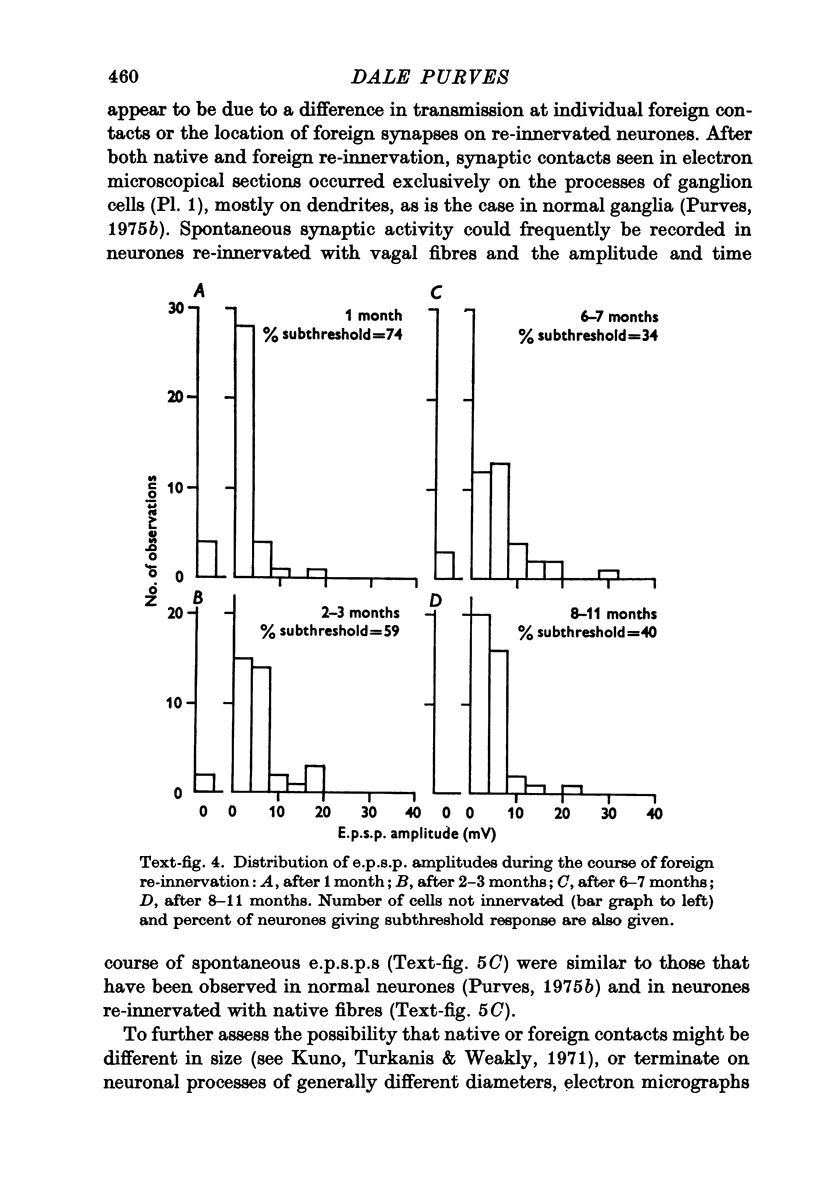
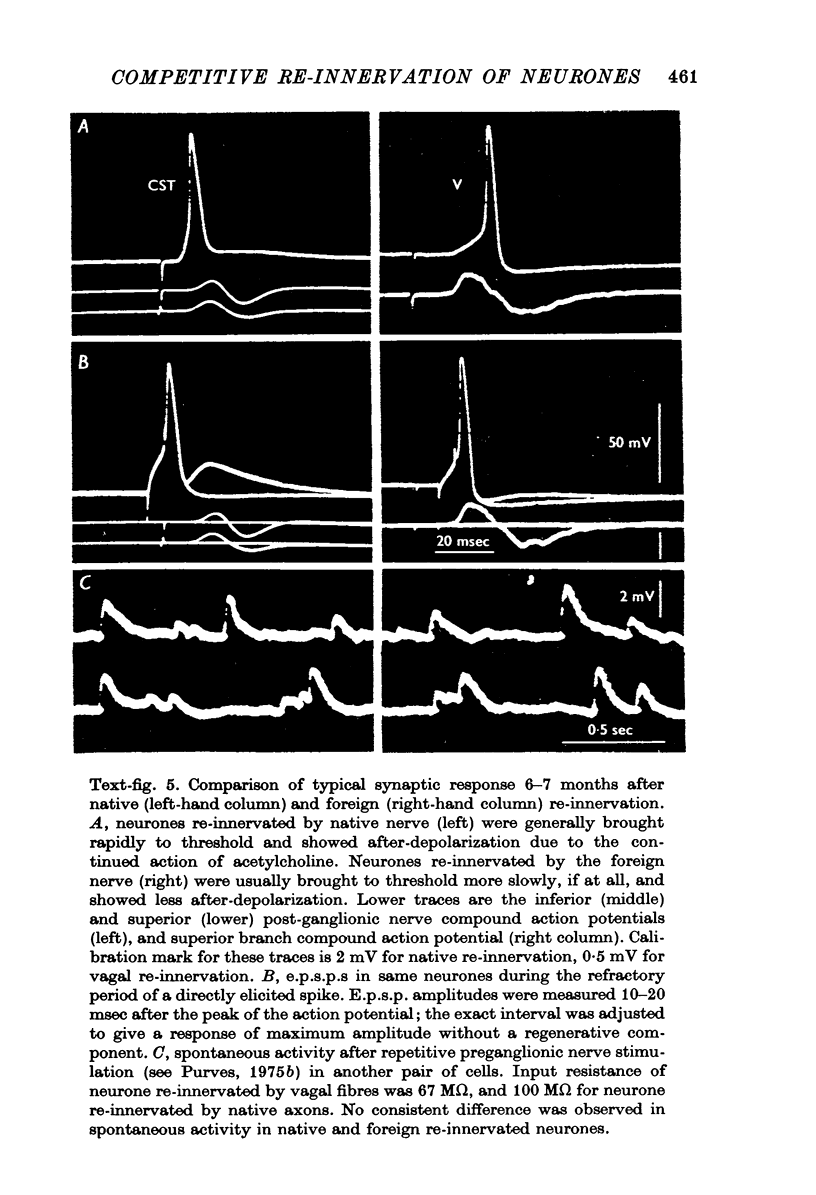
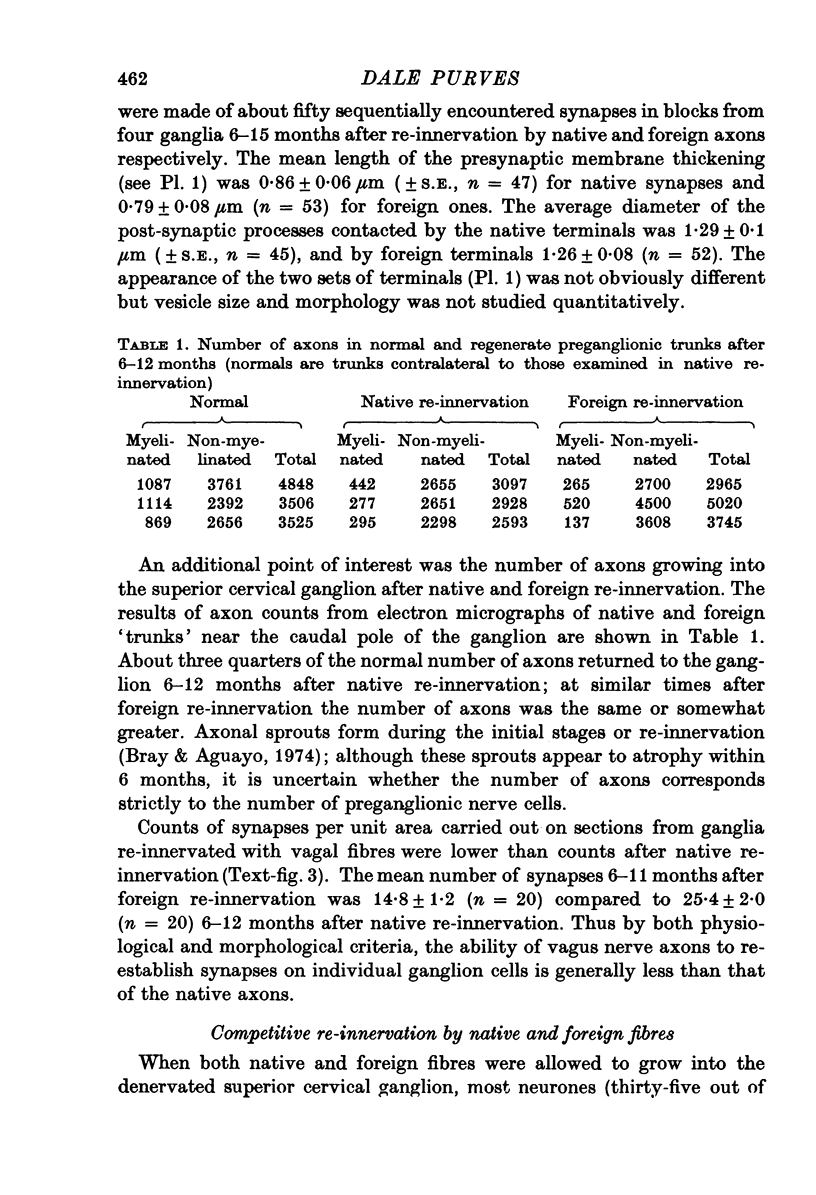
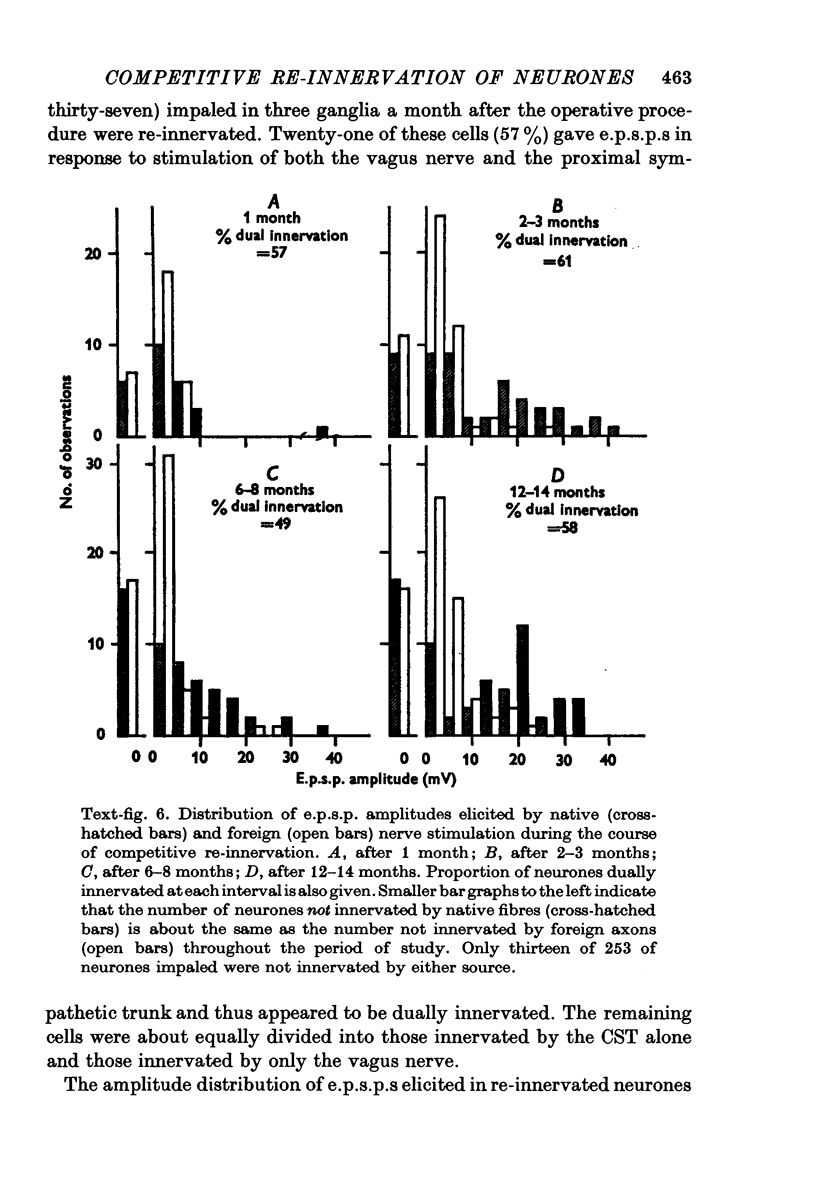
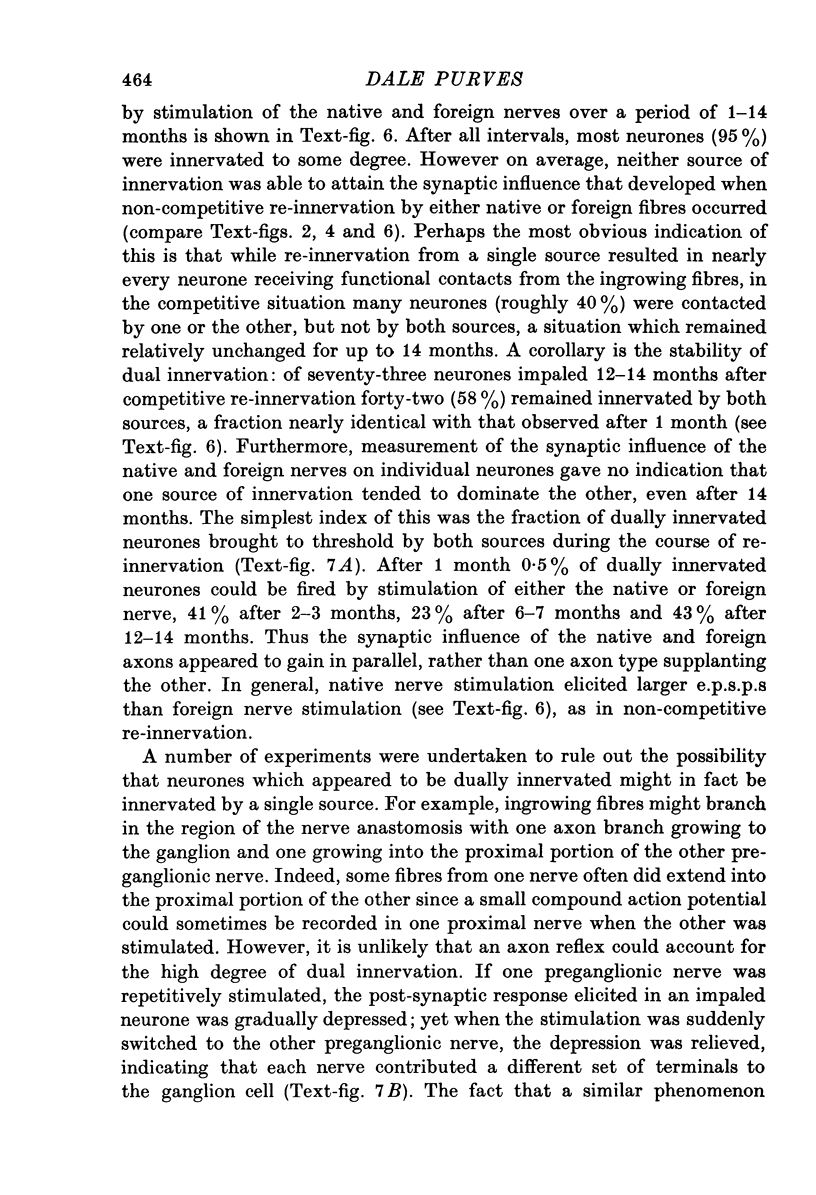
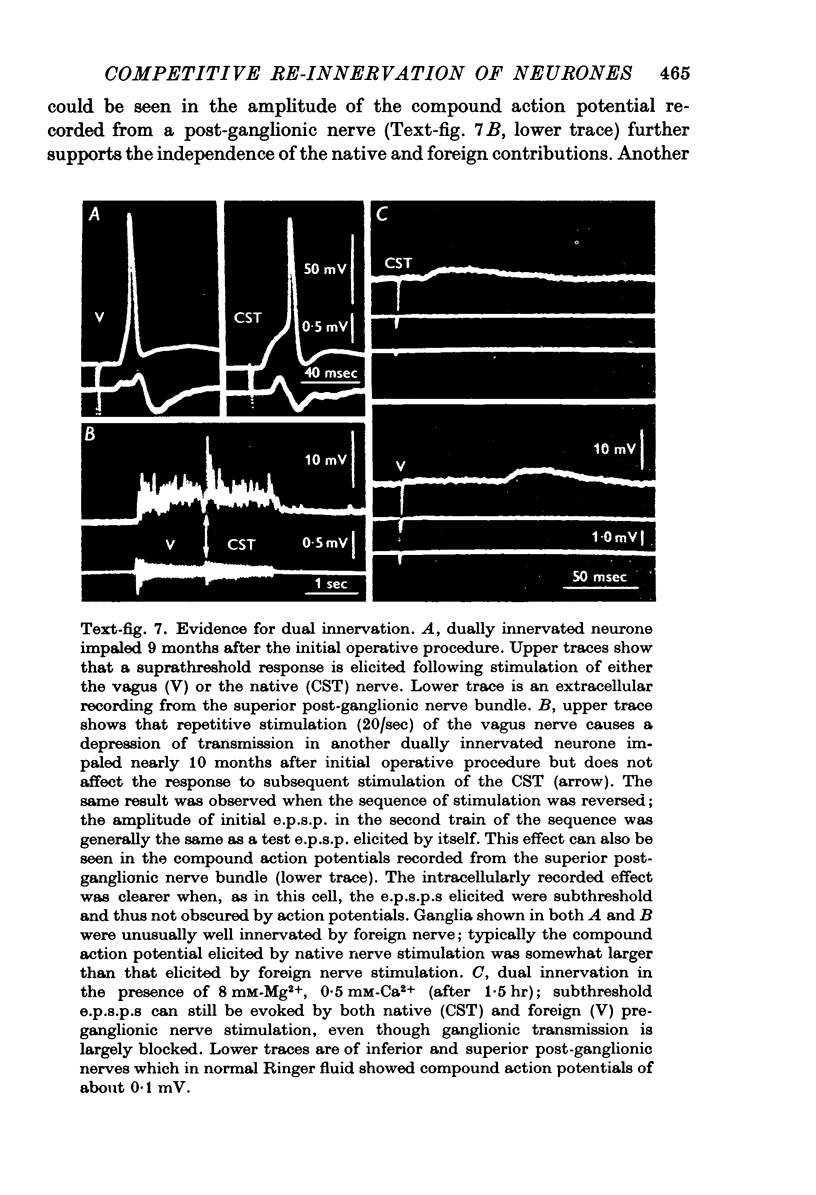
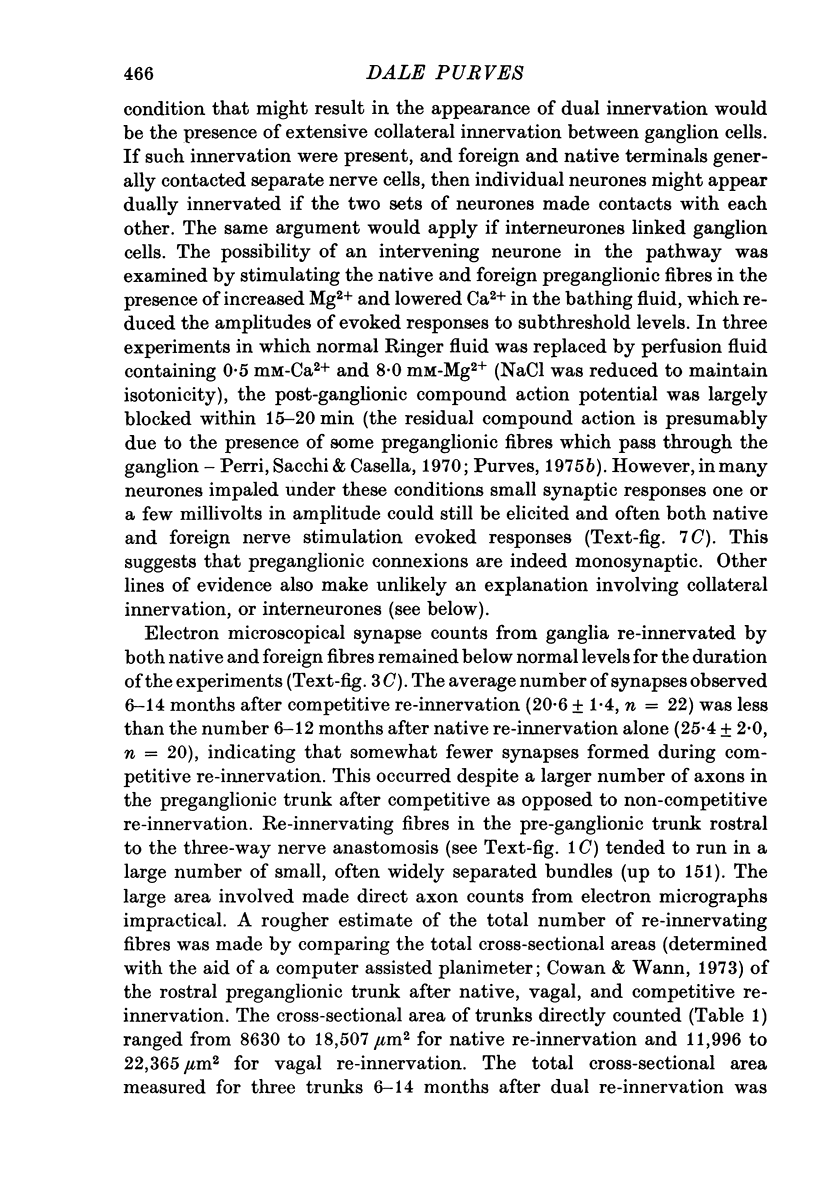
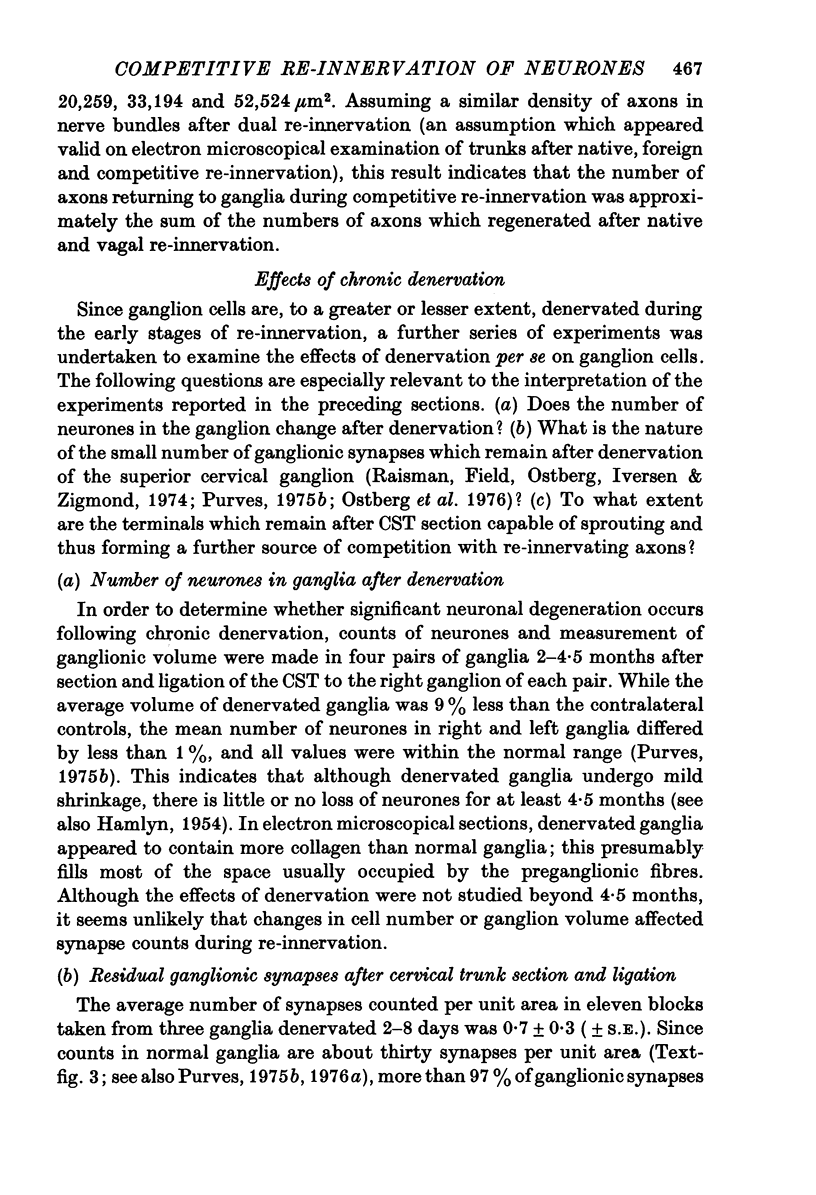
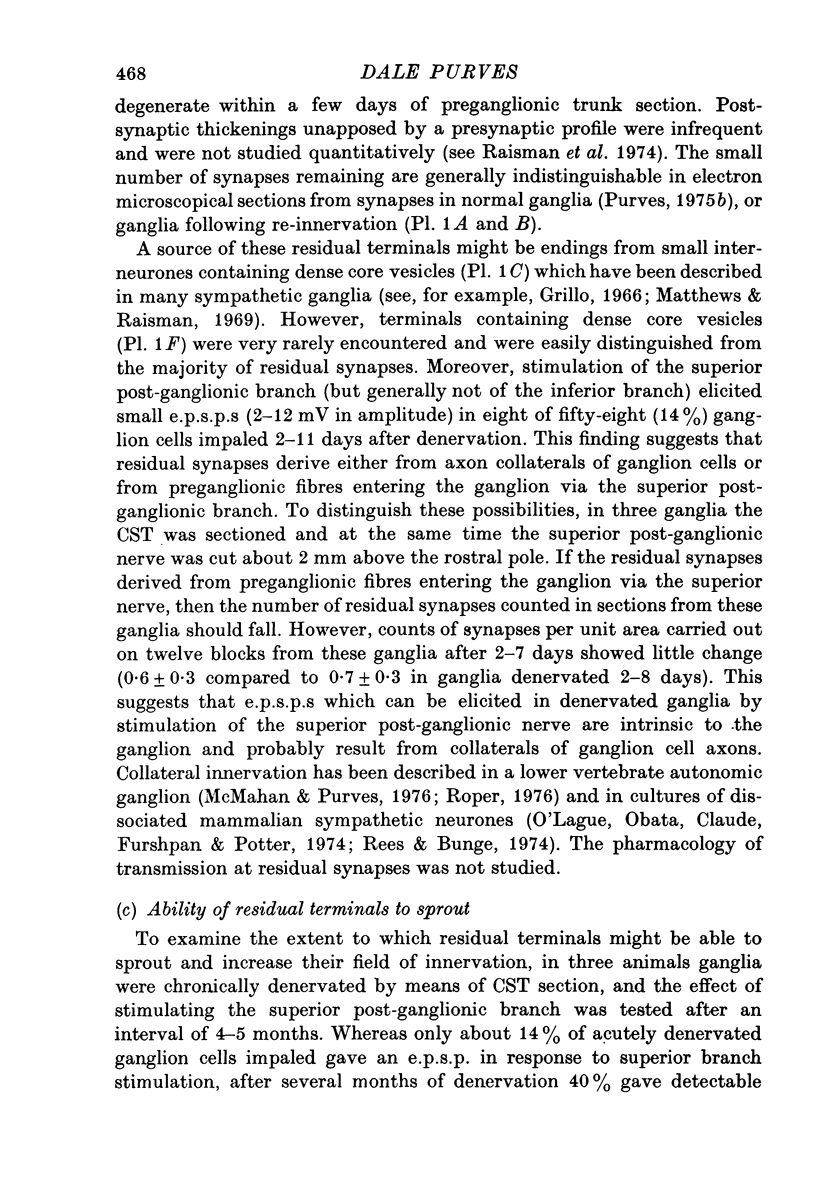
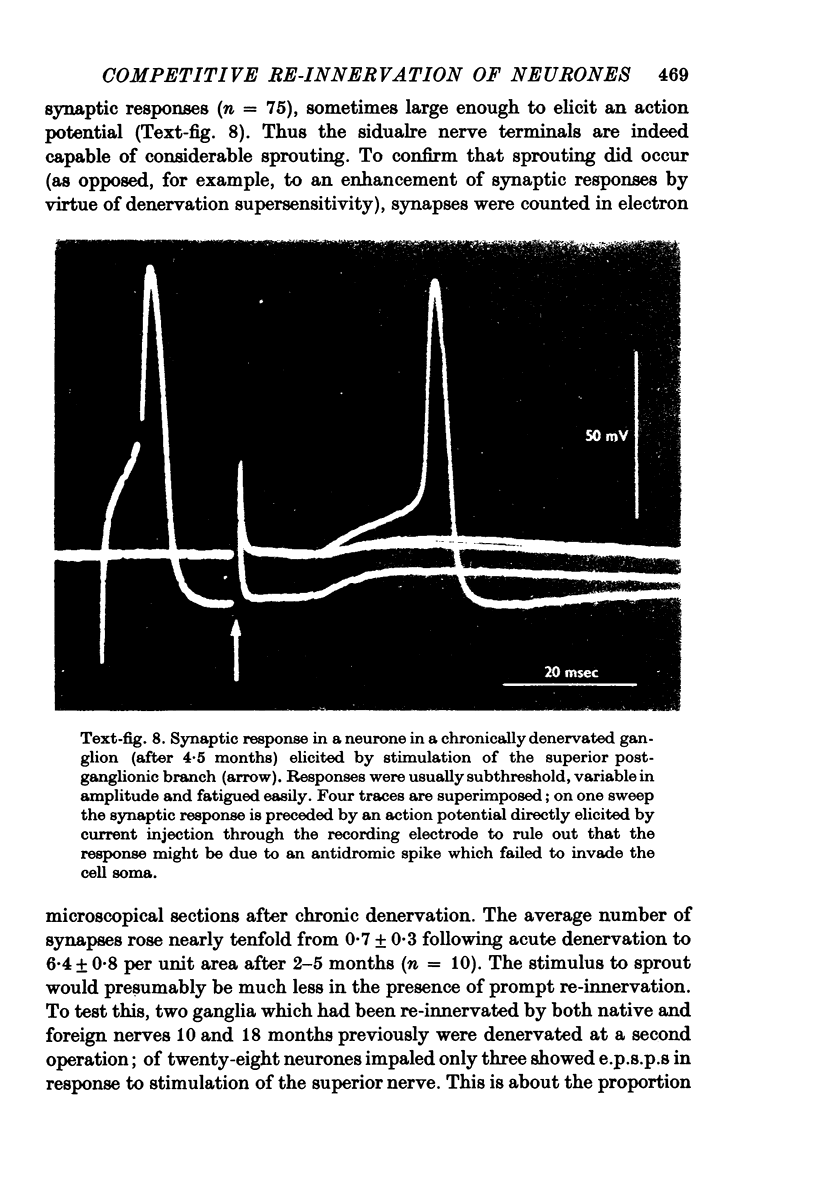
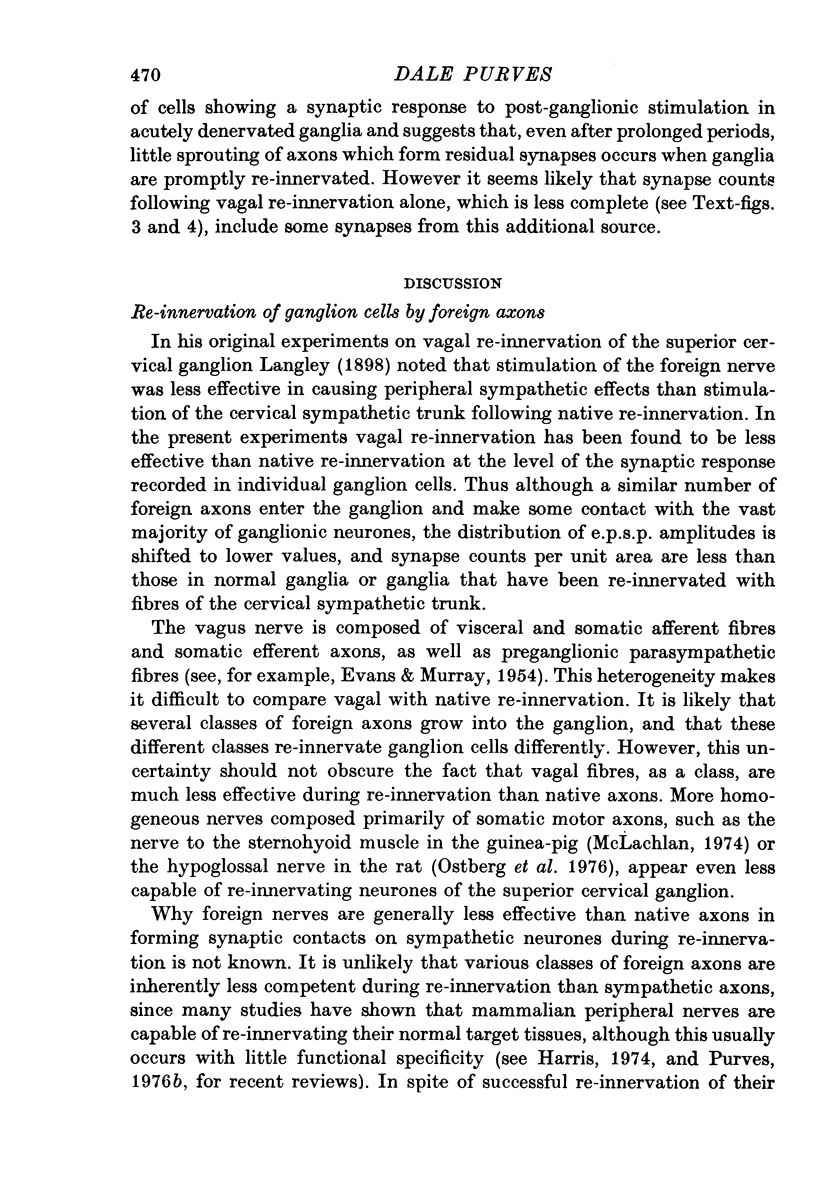
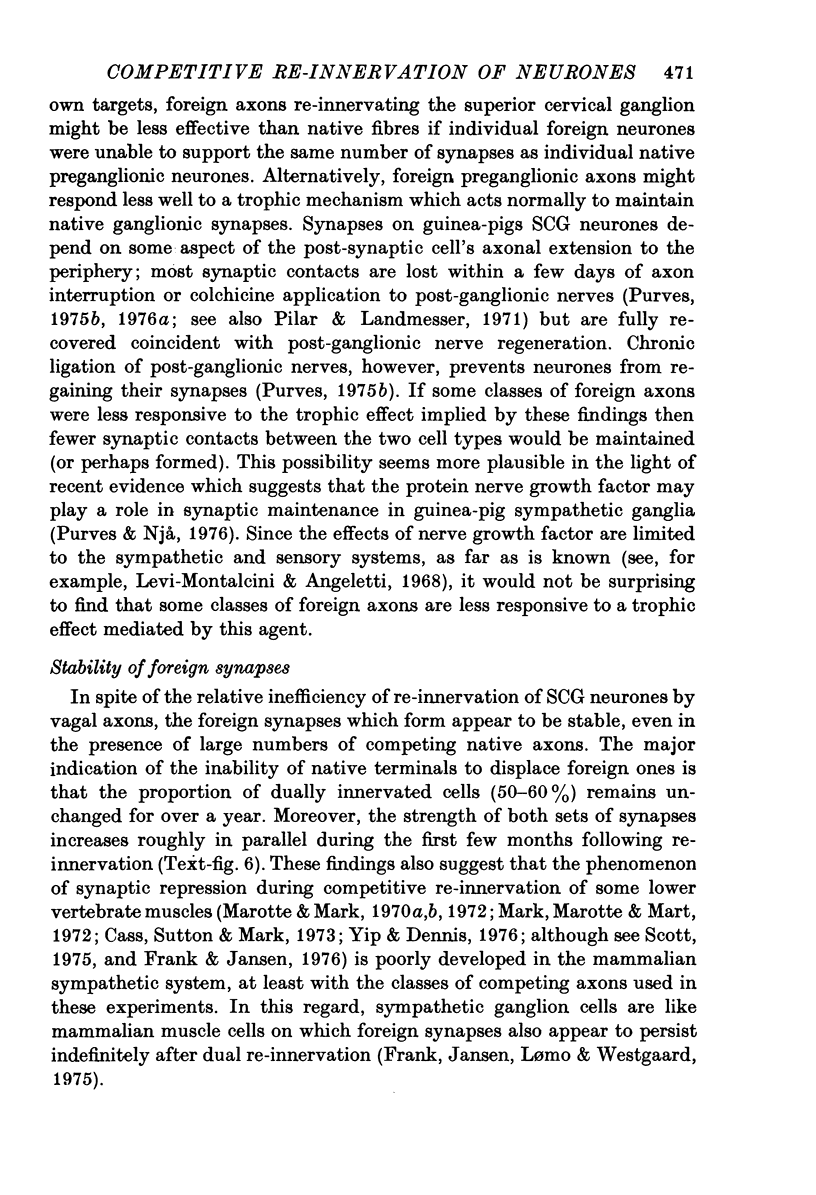
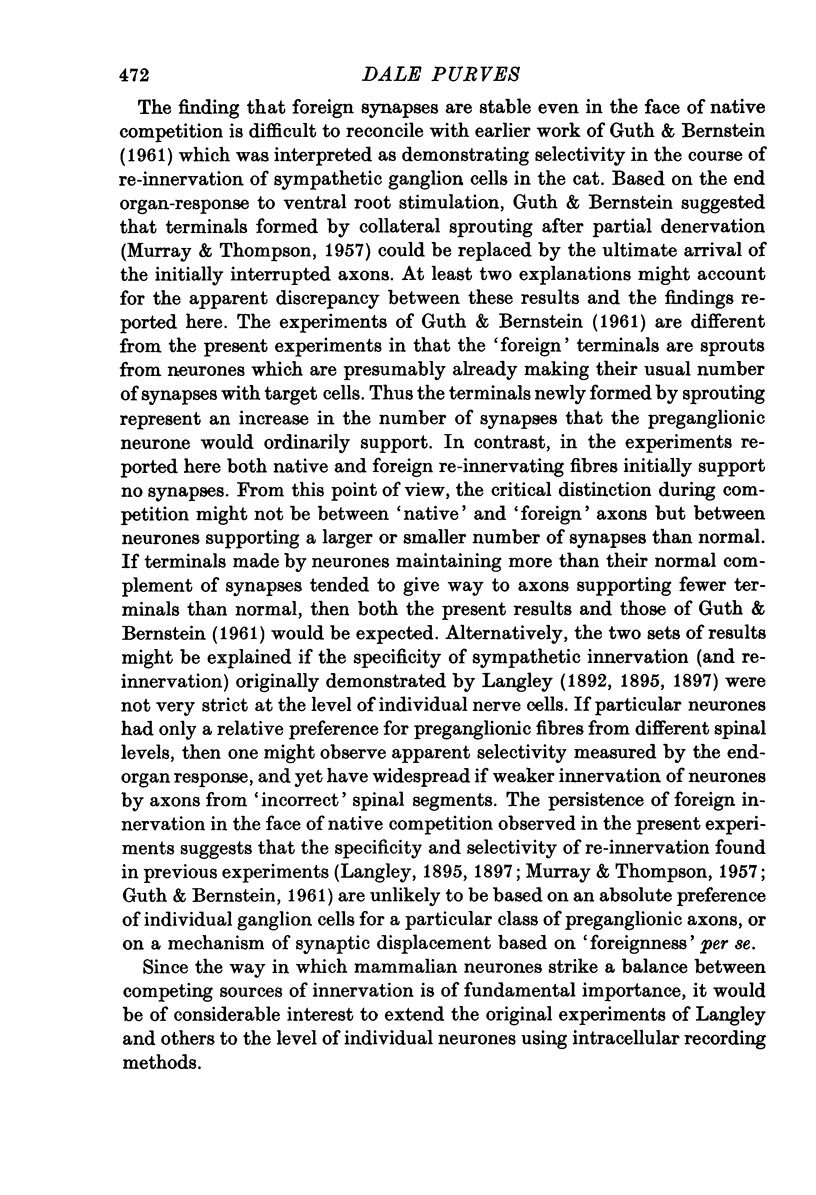
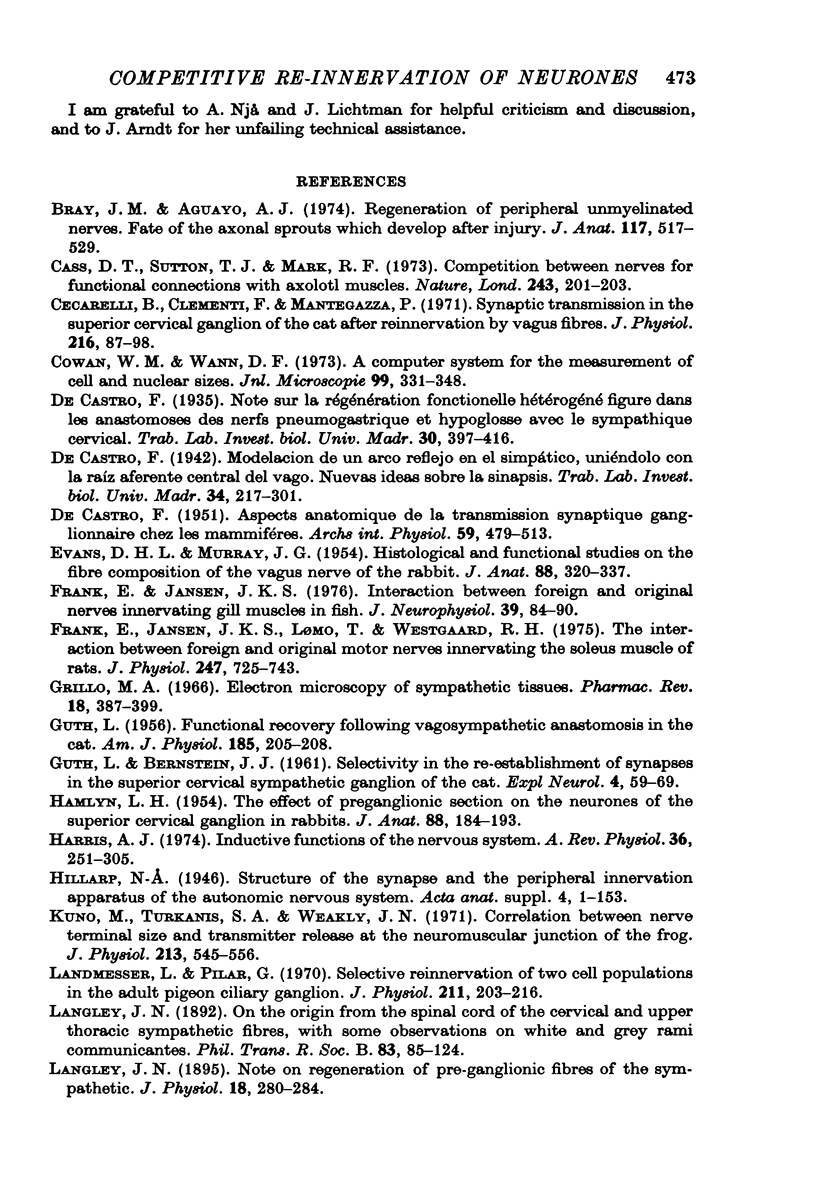
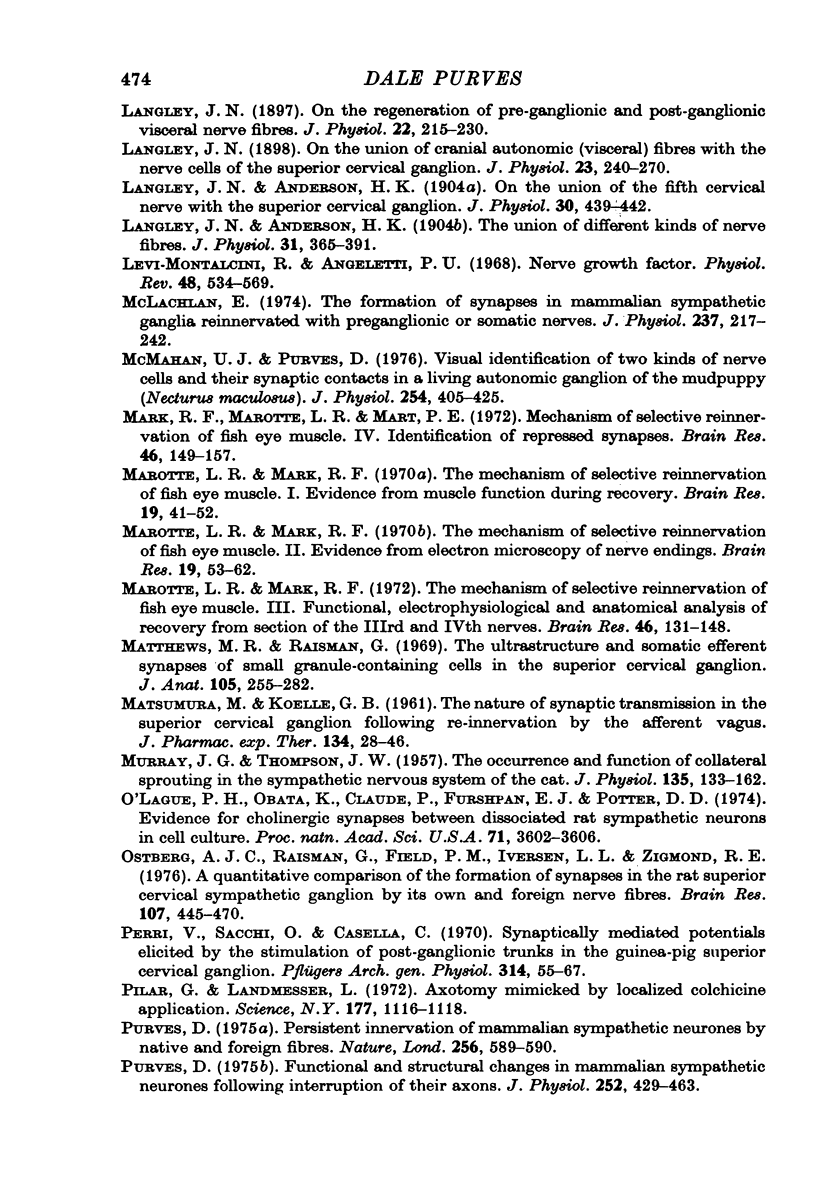
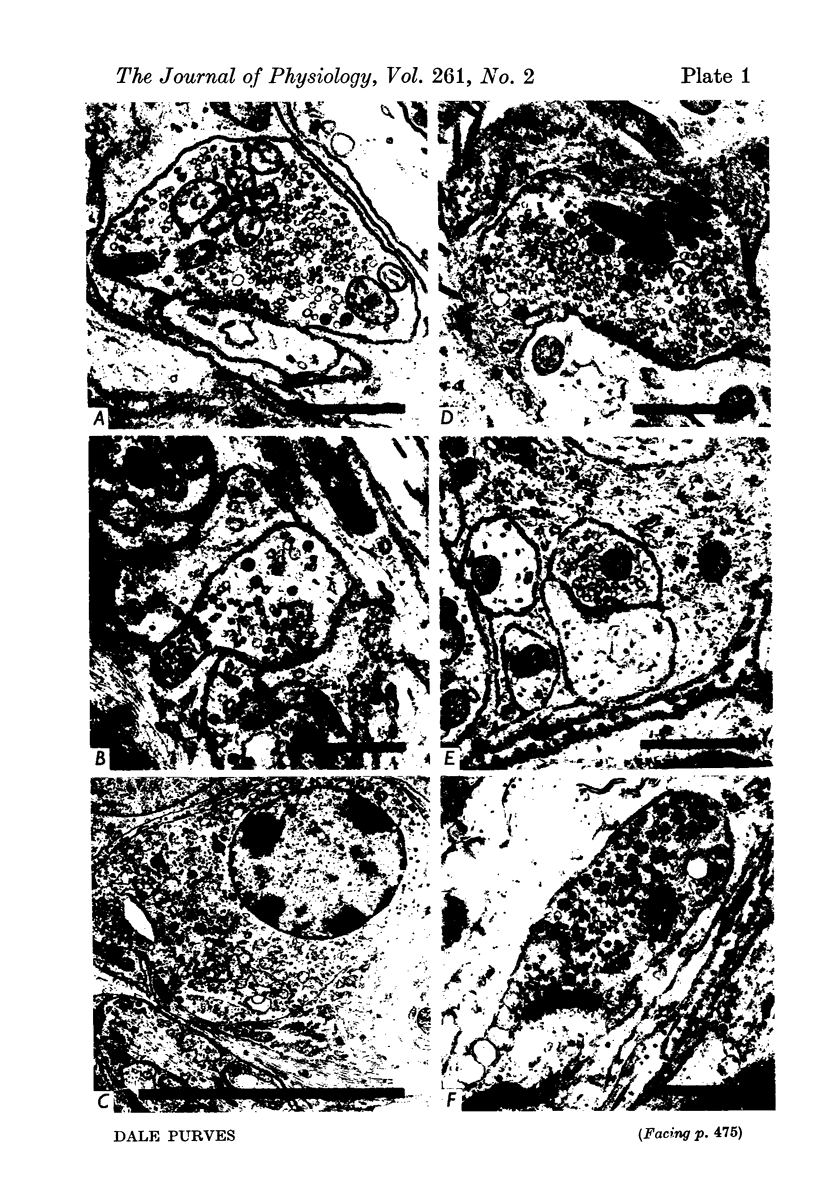
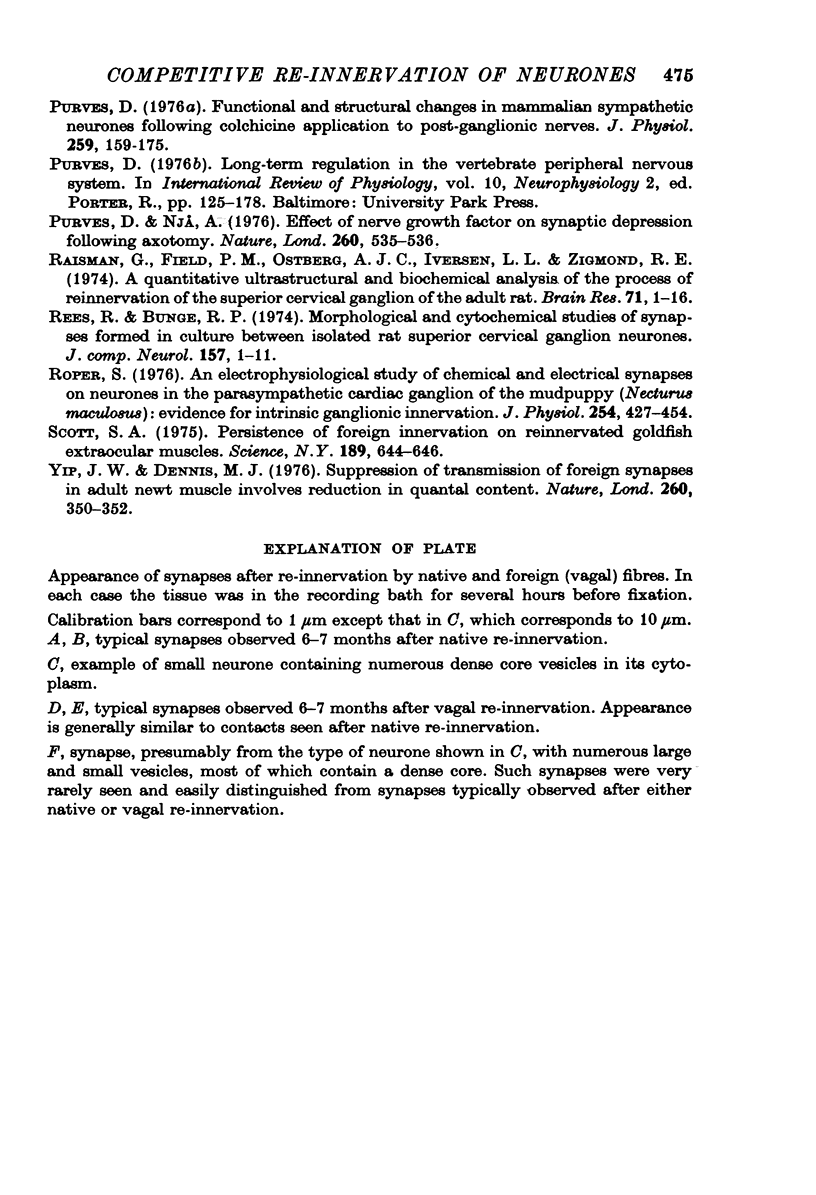
Images in this article
Selected References
These references are in PubMed. This may not be the complete list of references from this article.
- Bray G. M., Aguayo A. J. Regeneration of peripheral unmyelinated nerves. Fate of the axonal sprouts which develop after injury. J Anat. 1974 Jul;117(Pt 3):517–529. [PMC free article] [PubMed] [Google Scholar]
- Cass D. T., Sutton T. J., Mark R. F. Competition between nerves for functional connexions with axolotl muscles. Nature. 1973 May 25;243(5404):201–203. doi: 10.1038/243201a0. [DOI] [PubMed] [Google Scholar]
- Cowan W. M., Wann D. F. A computer system for the measurement of cell and nuclear sizes. J Microsc. 1973 Dec;99(3):331–348. doi: 10.1111/j.1365-2818.1973.tb04630.x. [DOI] [PubMed] [Google Scholar]
- DE CASTRO F. Aspects anatomiques de la transmission synaptique ganglionnaire chez les mammifères. Arch Int Physiol. 1951 Dec;59(4):479–525. doi: 10.3109/13813455109150845. [DOI] [PubMed] [Google Scholar]
- EVANS D. H., MURRAY J. G. Histological and functional studies on the fibre composition of the vagus nerve of the rabbit. J Anat. 1954 Jul;88(3):320–337. [PMC free article] [PubMed] [Google Scholar]
- Frank E., Jansen J. K. Interaction between foreign and original nerves innervating gill muscles in fish. J Neurophysiol. 1976 Jan;39(1):84–90. doi: 10.1152/jn.1976.39.1.84. [DOI] [PubMed] [Google Scholar]
- Frank E., Jansen J. K., Lomo T., Westgaard R. H. The interaction between foreign and original motor nerves innervating the soleus muscle of rats. J Physiol. 1975 Jun;247(3):725–743. doi: 10.1113/jphysiol.1975.sp010954. [DOI] [PMC free article] [PubMed] [Google Scholar]
- GUTH L., BERNSTEIN J. J. Selectivity in the re-establishment of synapses in the superior cervical sympathetic ganglion of the cat. Exp Neurol. 1961 Jul;4:59–69. doi: 10.1016/0014-4886(61)90078-4. [DOI] [PubMed] [Google Scholar]
- GUTH L. Functional recovery following vagosympathetic anastomosis in the cat. Am J Physiol. 1956 Apr;185(1):205–208. doi: 10.1152/ajplegacy.1956.185.1.205. [DOI] [PubMed] [Google Scholar]
- Grillo M. A. Electron microscopy of sympathetic tissues. Pharmacol Rev. 1966 Mar;18(1):387–399. [PubMed] [Google Scholar]
- HAMLYN L. H. The effect of preganglionic section on the neurons of the superior cervical ganglion in rabbits. J Anat. 1954 Apr;88(2):184–191. [PMC free article] [PubMed] [Google Scholar]
- Kuno M., Turkanis S. A., Weakly J. N. Correlation between nerve terminal size and transmitter release at the neuromuscular junction of the frog. J Physiol. 1971 Mar;213(3):545–556. doi: 10.1113/jphysiol.1971.sp009399. [DOI] [PMC free article] [PubMed] [Google Scholar]
- Landmesser L., Pilar G. Selective reinnervation of two cell populations in the adult pigeon ciliary ganglion. J Physiol. 1970 Nov;211(1):203–216. doi: 10.1113/jphysiol.1970.sp009275. [DOI] [PMC free article] [PubMed] [Google Scholar]
- Langley J. N., Anderson H. K. On the union of the fifth cervical nerve with the superior cervical ganglion. J Physiol. 1904 Feb 25;30(5-6):439–442. doi: 10.1113/jphysiol.1904.sp001005. [DOI] [PMC free article] [PubMed] [Google Scholar]
- Langley J. N., Anderson H. K. The union of different kinds of nerve fibres. J Physiol. 1904 Aug 22;31(5):365–391. doi: 10.1113/jphysiol.1904.sp001042. [DOI] [PMC free article] [PubMed] [Google Scholar]
- Langley J. N. Note on Regeneration of Prae-Ganglionic Fibres of the Sympathetic. J Physiol. 1895 Jul 18;18(3):280–284. doi: 10.1113/jphysiol.1895.sp000566. [DOI] [PMC free article] [PubMed] [Google Scholar]
- Langley J. N. On the Regeneration of Pre-Ganglionic and of Post-Ganglionic Visceral Nerve Fibres. J Physiol. 1897 Nov 20;22(3):215–230. doi: 10.1113/jphysiol.1897.sp000688. [DOI] [PMC free article] [PubMed] [Google Scholar]
- Langley J. N. On the Union of Cranial Autonomic (Visceral) Fibres with the Nerve Cells of the Superior Cervical Ganglion. J Physiol. 1898 Jul 26;23(3):240–270. doi: 10.1113/jphysiol.1898.sp000726. [DOI] [PMC free article] [PubMed] [Google Scholar]
- Levi-Montalcini R., Angeletti P. U. Nerve growth factor. Physiol Rev. 1968 Jul;48(3):534–569. doi: 10.1152/physrev.1968.48.3.534. [DOI] [PubMed] [Google Scholar]
- MATSUMURA M., KOELLE G. B. The nature of synaptic transmission in the superior cervical ganglion following reinnervation by the afferent vagus. J Pharmacol Exp Ther. 1961 Oct;134:28–46. [PubMed] [Google Scholar]
- MURRAY J. G., THOMPSON J. W. The occurrence and function of collateral sprouting in the sympathetic nervous system of the cat. J Physiol. 1957 Jan 23;135(1):133–162. doi: 10.1113/jphysiol.1957.sp005700. [DOI] [PMC free article] [PubMed] [Google Scholar]
- Mark R. F., Marotte L. R., Mart P. E. The mechanism of selective reinnervation of fish eye muscles. IV. Identification of repressed synapses. Brain Res. 1972 Nov 13;46:149–157. doi: 10.1016/0006-8993(72)90012-1. [DOI] [PubMed] [Google Scholar]
- Mark R. F., Marotte L. R. The mechanism of selective reinnervation of fish eye muscles. 3. Functional, electrophysiological and anatomical analysis of recovery from section of 3rd and IVth nerves. Brain Res. 1972 Nov 13;46:131–148. doi: 10.1016/0006-8993(72)90011-x. [DOI] [PubMed] [Google Scholar]
- Marotte L. R., Mark R. F. The mechanism of selective reinnervation of fish eye muscle. I. Evidence from muscle function during recovery. Brain Res. 1970 Apr 1;19(1):41–51. doi: 10.1016/0006-8993(70)90235-0. [DOI] [PubMed] [Google Scholar]
- Marotte L. R., Mark R. P. The mechanism of selective reinnervation of fish eye muscle. II. Evidence from electronmicroscopy of nerve endings. Brain Res. 1970 Apr 1;19(1):53–62. doi: 10.1016/0006-8993(70)90236-2. [DOI] [PubMed] [Google Scholar]
- Matthews M. R., Raisman G. The ultrastructure and somatic efferent synapses of small granule-containing cells in the superior cervical ganglion. J Anat. 1969 Sep;105(Pt 2):255–282. [PMC free article] [PubMed] [Google Scholar]
- McLachlan E. M. The formation of synapses in mammalian sympathetic ganglia reinnervated with preganglionic or somatic nerves. J Physiol. 1974 Feb;237(1):217–242. doi: 10.1113/jphysiol.1974.sp010479. [DOI] [PMC free article] [PubMed] [Google Scholar]
- O'Lague P. H., Obata K., Claude P., Furshpan E. J., Potter D. D. Evidence for cholinergic synapses between dissociated rat sympathetic neurons in cell culture. Proc Natl Acad Sci U S A. 1974 Sep;71(9):3602–3606. doi: 10.1073/pnas.71.9.3602. [DOI] [PMC free article] [PubMed] [Google Scholar]
- Ostberg A. J., Raisman G., Field P. M., Iversen L. L., Zigmond R. E. A quantitative comparison of the formation of synapses in the rat superior cervical sympathetic ganglion by its own and by foreign nerve fibres. Brain Res. 1976 May 14;107(3):445–470. doi: 10.1016/0006-8993(76)90137-2. [DOI] [PubMed] [Google Scholar]
- Perri V., Sacchi O., Casella C. Synaptically mediated potentials elicited by the stimulation of post-ganglionic trunks in the guinea-pig superior cervical ganglion. Pflugers Arch. 1970;314(1):55–67. doi: 10.1007/BF00587046. [DOI] [PubMed] [Google Scholar]
- Pilar G., Landmesser L. Axotomy mimicked by localized colchicine application. Science. 1972 Sep 22;177(4054):1116–1118. doi: 10.1126/science.177.4054.1116. [DOI] [PubMed] [Google Scholar]
- Purves D. Persistent innervation of mammalian sympathetic neurones by native and foreign fibres. Nature. 1975 Aug 14;256(5518):589–590. doi: 10.1038/256589a0. [DOI] [PubMed] [Google Scholar]
- Raisman G., Field P. M., Ostberg A. J., Iversen L. L., Zigmond R. E. A quantitative ultrastructural and biochemical analysis of the process of reinnervation of the superior cervical ganglion in the adult rat. Brain Res. 1974 May 10;71(1):1–16. doi: 10.1016/0006-8993(74)90187-5. [DOI] [PubMed] [Google Scholar]
- Rees R., Bunge R. P. Morphological and cytochemical studies of synapses formed in culture between isolated rat superior cervical ganglion neurons. J Comp Neurol. 1974 Sep 1;157(1):1–11. doi: 10.1002/cne.901570102. [DOI] [PubMed] [Google Scholar]
- Roper S. An electrophysiological study of chemical and electrical synapses on neurones in the parasympathetic cardiac ganglion of the mudpuppy, Necturus maculosus: evidence for intrinsic ganglionic innervation. J Physiol. 1976 Jan;254(2):427–454. doi: 10.1113/jphysiol.1976.sp011239. [DOI] [PMC free article] [PubMed] [Google Scholar]
- Yip J. W., Dennis M. J. Suppression of transmission at foreign synapses in adult newt muscle involves reduction in quantal content. Nature. 1976 Mar 25;260(5549):350–352. doi: 10.1038/260350a0. [DOI] [PubMed] [Google Scholar]



